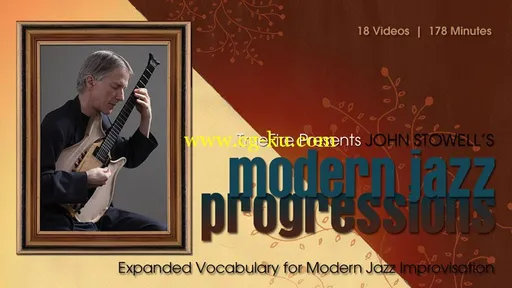
TrueFire - Modern Jazz Progressions
(.mp4) in an interactive shell | English | 864 x 486 | AVC ~967 Kbps | 29.970 fps
AAC | 128 Kbps | 44.1 KHz | 2 channels | ~3 hours | 1.49 GB
Genre: eLearning Video / Guitar lesson, Jazz (2015)
The club is packed to the rafters with jazz freaks and monster players. First set, very first tune, and the sax player's solo has already pulled the audience to the edge of their seats. The next three choruses are yours for the asking but you pass the nod on to the keys 'cause you're just not feeling it lately. You're making the changes but the sparkle's gone AWOL from your improvisations. Yup, we've all been there. But no worries... our resident professor of jazz sparkle, John Stowell has your back with some fresh perspective for crafting fresh lines over commonly encountered chord progressions.
In Modern Jazz Progressions, John reveals how to apply four modes of the melodic and harmonic minor to generate tensions and mega-sparkle over the dominant chords commonly found in jazz chord progressions. Melodic and harmonic minor chords function as altered dominant chords for modern jazz players, and so the applications that John shows you will also spice up your lines when making a minor iii or vi chord dominant.
The four melodic and harmonic minor modes that you'll be working with are the Super Locrian (a half-step above the dominant chord), the Sus Flat 2 (a whole tone below the dominant), the Mixolydian Flat 6 (a fourth above the dominant), and the Lydian Dominant (a fifth above the dominant).
Essentially you'll learn how to develop compelling melodic lines by mixing dominant arpeggios and scales with arpeggios and scales derived from the four modes. Sounds a little like rocket science? Indeed it is, BUT... there is method to the madness and John's intuitive teaching approach in Modern Jazz Progressions will connect the dots for you quickly.
Stowell guides you through six versions of a ii-V-I-vi progression, four versions of a minor blues progression and four versions of a dominant blues progression. Each version of each progression escalates in sophistication so that your ear can acclimate to the new sounds that you'll be creating along the way.
John will demonstrate line construction over rhythm tracks calling out both the embellishments he is using (notes inside the scale to extend the harmony) and tensions (notes outside of the scale -- specifically, notes from one or more of the four melodic and harmonic minor modes). Playalongs are included within each demonstration so that you can apply the moves that John demonstrates immediately in context.
John concludes the course with some sage advice on comping and playing solo. He shows how to achieve a pianistic style of comping that makes use of close intervals, open strings, and broken chords that add depth to your playing while making difficult changes easier to play. If you play solo or chord melody, this section alone is a gold mine.
Modern Jazz Progressions is not a vocabulary building course and while we have transcribed some of the tastier lines (standard notation only - no tab), it is not John's intention to have you learn his lines note-for-note. It's the underlying harmonic and creative approach that John wants students to grasp and then apply in their own lines.
Table of Contents
18 Total Video Lessons
Modern Jazz Progressions
Single-Line Substitutions
ii-V-I-vi Progression
ii-V-I-vi Progression
ii-V-I-vi Progression
ii-V-I-vi Progression
ii-V-I-vi Progression
ii-V-I-vi Progression
Minor Blues Progression
Minor Blues Progression
Minor Blues Progression
Minor Blues Progression
Dominant Blues Progression
Dominant Blues Progression
Dominant Blues Progression
Dominant Blues Progression
Comping Tips
Modern Jazz Progressions


发布日期: 2015-09-10